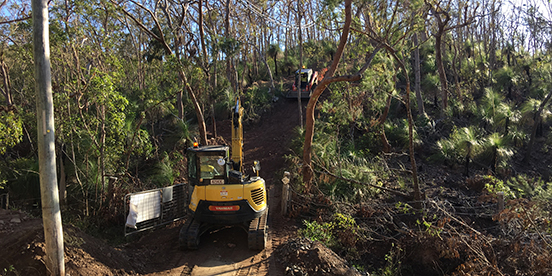Cable Augmentation Project: Lighting up the Whitsundays!


Up on the beautiful tropical coast of Queensland, Zinfra crews are ensuring holiday makers and residents at the Whitsundays have continuous power supply irrespective of what mother nature may have in mind!
Delivering under a long term services arrangement with Ergon Energy, Zinfra has almost completed an Emergency Works package on the outskirts of Airlie Beach in Queensland, known as the ‘Ergon Energy Stoney Creek Whitsunday Cable Augmentation Project’.
Aerial bundled cable (ABC) overhead power lines previously ran approximately one kilometre from the Shute Haven 66/22kV substation to submarine cables at Coral Beach. These cables were the main supply of power to Hamilton, Hayman and Daydream Islands in the Whitsundays. Regular, severe weather events including recurring cyclones kept impacting these overhead feeders causing power outages on the islands.
Zinfra was engaged initially to advise on the viability of installing underground cables, given the sensitive location and difficult terrain. A positive determination from these initial discussions, coupled with Zinfra’s capabilities and ‘can do’ attitude, meant it was engaged to deliver the works.
The scope of works included trench excavation along with conduit, cable, RMU and pole installation, cable jointing, then removal of the old poles and ABCs, followed by the reinstatement of the track’s surface.
This challenging project took place on the ridgeline of Mount Rooper in Conway National Park, whose incline varies between 11 and 22 degrees and is clearly visible to passing tourists as they make their way to and from the islands.
The ridgeline’s canopy and undergrowth are home to an array of environmentally sensitive flora and fauna. As a result of these factors Zinfra crews had to complete the work within a narrow easement only 4.5 metres wide and to adhere to strict environmental controls.
Undulating subterranean rock formations, presented difficult conditions for trenching. An undocumented (no DBYD) fibre optic cable within the alignment and high voltage overhead mains just 4.2 metres from the ground added to the challenges experienced on site.
Additional excavation was required to maintain Minimum Approach Distances and due to the terrain, manual pot holing was required to identify services in the rocky ground. The rock was such an impediment that trenching on some days advanced only 20 metres.
The logistics of moving crews, plant and materials safely and efficiently along the narrow ridgeline easement to and from the work sites had to be carefully planned and choreographed.
Open radio communication between all crew members and external deliverers was essential to the success of the project as it allowed the crews to coordinate and stage the delivery of materials and equipment using a ‘Just In Time’ strategy to prevent materials and plant from blocking the access route. Maintaining clear access and egress routes was challenging but an extremely important part of the emergency evacuation plan.
Excellent planning, innovating and adapting by Zinfra crews on site, with outstanding collaboration and support from the client, has contributed greatly to the success of the project to date and no health, safety or environmental incidents have occurred.